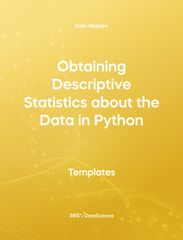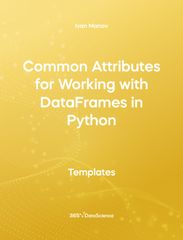Data Science Templates
Boost your programming skills with free SQL, R, Excel, and Python templates and create top-notch projects for your portfolio.Accelerate your workflow with code-ready data science templates from 365 Data Science instructors—designed to enhance efficiency in your programming projects.
Discover a myriad of valuable resources—from a time-saving data science cheat sheet to data analysis and visualization templates in Excel and ready-to-use SQL, R, and Python coding shortcuts.
Whether you’re unsure how to approach a task or work on a time-sensitive project, these templates are designed to streamline your work and enhance productivity.
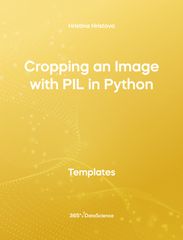
Cropping an Image with PIL in Python
The following notebook demonstrates how to crop a rectangular section of an image with the help of the PIL library in Python. Some other related topic you might be interested in are Line and Scatterplots with matplotlib in Python, Opening and Displaying an Image with PIL and Matplotlib in Python, Resizing an Image with PIL in Python, Converting a Color Image to Grayscale with PIL in Python, Blurring an Image with PIL in Python, Writing a Text on Top of an Image with PIL in Python. The Cropping an Image with PIL in Python template is among the topics covered in detail in the 365 Data Science Program.
Learn More
Opening and Displaying an Image with PIL and Matplotlib in Python
The following notebook demonstrates how to display an image using Python and how to extract information about its size, format and mode. Some other related topics you might e interest4d in are Line and Scatterplots with matplotlib in Python, Cropping an Image with PIL in Python, Resizing an Image with PIL in Python, Converting a Color image to Grayscale with PIL in Python, Blurring an Image with PIL in Python, Writing a Text on Top of an Image with PIL in Python. The Opening and Displaying an Image with PIL and Matplotlib in Python template is among the topics covered in detail in the 365 Data Science Program.
Learn More
Class Variables in Python
In Python, we can design and create our own objects. This is done with the help of classes. The following template shows how to implement a simple class consisting of a constructor and a class variable. Some other related topics you might find interesting are The pass-statement in Python, Creating a constructor in Python - the INIT method, Methods in Python - functions inside classes, Inheritance in Python, and Defining classes in Python. The Class Variables in Python template is among the topics covered in detail in the 365 Data Science Program.
Learn More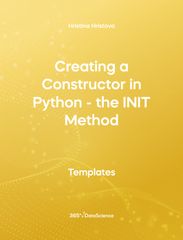
Creating a Constructor in Python - the INIT Method
In this free Jupyter notebook, we create a class and define a constructor through the __init__ method. This helps control the variables that enter an object. We then define two different instances of this class and show how to retrieve information from them. Some other related topics you might be interested in are Defining classes in Python, The pass-statement in Python, Class variables in Python, Methods in Python - functions inside classes, and Inheritance in Python. This Creating a Constructor in Python- the INIT Method template is among the topics covered in detail in the 365 Data Science Program.
Learn More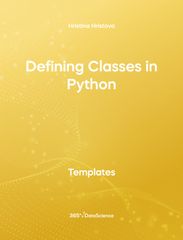
Defining Classes in Python
In Python, we can design and create our own objects. This is done with the help of classes. In this template notebook, we define a very simplistic class without a body and create an object which is an instance of that class. Finally, we store and retrieve information from that object. Some other related topics you might be interested in are Creating a constructor in Python - the INIT method, The pass-statement in Python, Class variables in Python, Methods in Python - functions inside classes, Inheritance in Python. The Defining Classes in Python template is among the topics covered in the 365 Data Science Program.
Learn More
The Pass-Statement in Python
This free template helps your code writing by showing you the ability to define a function, a class, a loop or an if-statement but leave it empty for the time-being. This is what the pass-statement allows us to do. Some other related topics you might be interested in are Defining classes in Python, Creating a constructor in Python - the INIT method, Class variables in Python, Methods in Python - functions inside classes, Inheritance in Python. The Pass-Statement in Python template is among the topics covered in detail in the 365 Program.
Learn More
Recursion in Python - the Fibonacci Sequence
Functions in Python have the ability to call themselves. This is what we call a recursion. In this template you will find an implementation of the Fibonacci sequence using recursion. Some other related topics you might be interested in are Recursion in Python - the Fibonacci sequence, The pass-statement in Python, Methods in Python - functions inside classes. The Recursion in Python - the Fibonacci Sequence in Python is among the topics covered in detail in the 365 Program.
Learn More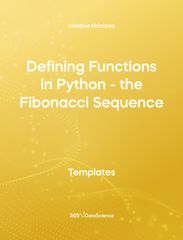
Defining Functions in Python - the Fibonacci Sequence
In this notebook you will find examples of function definitions with and without returning a value. You will find an implementation of the Fibonacci sequence which returns the n-th Fibonacci number, where n is a number determined by the user and understand the purpose of a docstring. Some other related topics you might be interested in are The enumerate function in Python, Using Counter - a dictionary subclass in Python, and One-Dimensional Dictionaries in Python template. The Defining Functions in Python - the Fibonacci Sequence Python is among the topics covered in the 365 Program.
Learn More
Open, Close, Read, Write and Append to Files in Python
The following notebook template guides you through the process of creating a file and writing information in it using Python code. You will also learn how to append to a file and read the information from it. Some other related topics you might be interested in are Using Counter - a dictionary subclass in Python, String formatting in Python, and While Loops in Python. The Open, Close, Read, Write and Append to Files in Python template is among the topics covered in detail in the 365 Program.
Learn More
The Zip Function in Python
The following template is a comprehensive introduction to the zip function in Python and the way it is used. We discuss what happens when two or more lists are zipped. We also take a look at how this function can be used to unzip values and store them in separate variables. Some other related topics you might be interested in are The enumerate function in Python, Defining functions in Python - the Fibonacci sequence, and One-Dimensional Dictionaries in Python template. The Zip Function in Python is among the topics covered in the 365 Program.
Learn More
Using Counter - a Dictionary Subclass in Python
The following is a program that demonstrates the usage of the Counter subclass. It is used to determine the frequency of all characters in a string. This Counter object is then converted into a dictionary. Dictionary comprehension is then used to remove unnecessary characters from the dictionary. Some other related topics you might be interested in are While Loops in Python, Dictionary Comprehension in Python, and Bubble Sort in Python . The Using Counter - a Dictionary Subclass in Python is among the topics covered in detail in the 365 Data Science program.
Learn More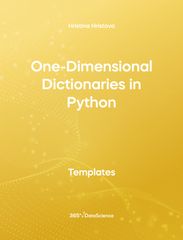
One-Dimensional Dictionaries in Python
The following template is a program implementing a dictionary in Python where the keys are a couple of countries. The values are their corresponding capitals. Within the notebook, it is demonstrated how to retrieve keys and values from the dictionary, how to create a new key: value pair and how to loop through the keys and the values using a for-loop. Some other related topics you might be interested in are While Loops in Python, Dictionary Comprehension in Python, and Using Counter - a Dictionary Subclass in Python. The One-Dimensional Dictionaries in Python template is among the topics covered in detail in the 365 Data Science program.
Learn More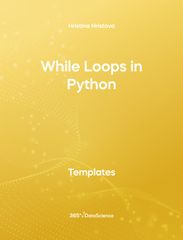
While-Loops in Python
The following is a program demonstrating the implementation of a while-loop. The program asks the user to input the ages of students in a class. Using a while-loop, these ages are stored in an array and printed out in the end. Some other related topics you might be interested in are Linear Search in Python, Binary Search in Python, Insertion Sort in Python, and Sets and Operations with Sets in Python. The While-Loops in Python template is among the topics covered in detail in the 365 Data Science Program.
Learn More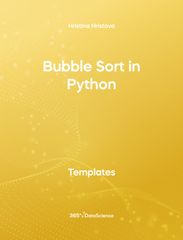
Bubble Sort in Python
The following is a program which makes use of for-loops to implement the bubble sort algorithm in a function. Some other related topics you might be interested in are Linear search in Python, Binary search in Python, Insertion sort in Python, Sets and operations with sets in Python. The Bubble Sort in Python template is among the topics covered in detail in the 365 Data Science Program
Learn More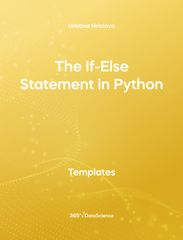
The If-Else Statement in Python
The following is a program demonstrating the implementation of the conditional if-else statement. The program asks the user to enter the temperature outside. It then gives recommendations on what actions the user needs to take. Some other related topics you might be interested in are True and False in Python, While-loops in Python, For-loops in Python. The If-Else Statement in Python template is among the topics covered in detail in the 365 Data Science Program.
Learn More
True and False in Python
The following notebook demonstrates the result of combining boolean expressions with the 'not', 'and', and 'or' logical operators. We first start simple by evaluating expressions containing two booleans and one logical operator. Then, we give and thoroughly explain a more intricate example containing several boolean expressions and operators. Some other related topics you might be interested in are The if-else statement in Python, While-loops in Python, and For-loops in Python. The True and False in Python template is among the topics covered in detail in the 365 Data Science program
Learn More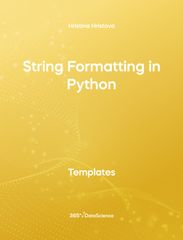
String Formatting in Python
In the following notebook template , you will find a series of examples that demonstrate the most important operations that one can perform on strings. From finding the length of a string all the way to creating a string storing a small poem and splitting it into separate words using the split() and strip() method. Some other related topics you might be interested in are User inputs in Python, Using Counter - a dictionary subclass in Python, Loops and if-statements, and Regular expressions in Python. The String Formatting in Python template is among the topics covered in detail in the 365 Data Science program
Learn More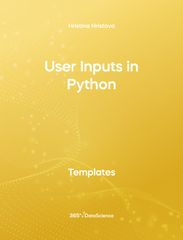
User Inputs in Python
The following template is a program which demonstrates how to ask the user for an input and store that input either as a string, or as an integer, depending on the needs. Some other related topics you might be interested in are String formatting in Python, The if-else statement in Python, While-loops in Python, For-loops in Python. The User Inputs in Python template is among the topics covered in detail in the 365 Data Science program.
Learn More
Getting the Current Time in Python
This is a template demonstrating how to estimate the local time in the current time zone. It shows the application of the .now() method. Some other related topics you might be interested in are Converting Strings into Datetime Objects in Python, Replacing the Values of Datetime Objects in Python, Getting the Date of the Week in Python and Working with Format Codes in Python. The Getting the Current Time in Python template is among the topics covered in detail in the 365 Data Science program.
Learn More
Converting Strings into Datetime Objects in Python
This is a template demonstrating how to convert string values into datetime objects and display these values in a user-friendly form in Python. It includes the application of the .strptime() method from the datetime module. Some other related topics you might be interested in are Timestamps in Python, Converting Datetime Objects into Strings in Python, Replacing the Values of Datetime Objects in Python, and Working with Format Codes in Python. The Converting Strings into Datetime Objects in Python template is among the topics covered in detail in the 365 Data Science program.
Learn More

